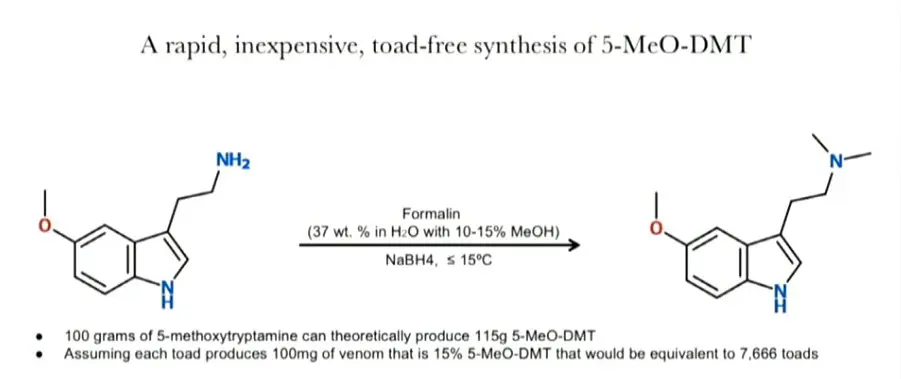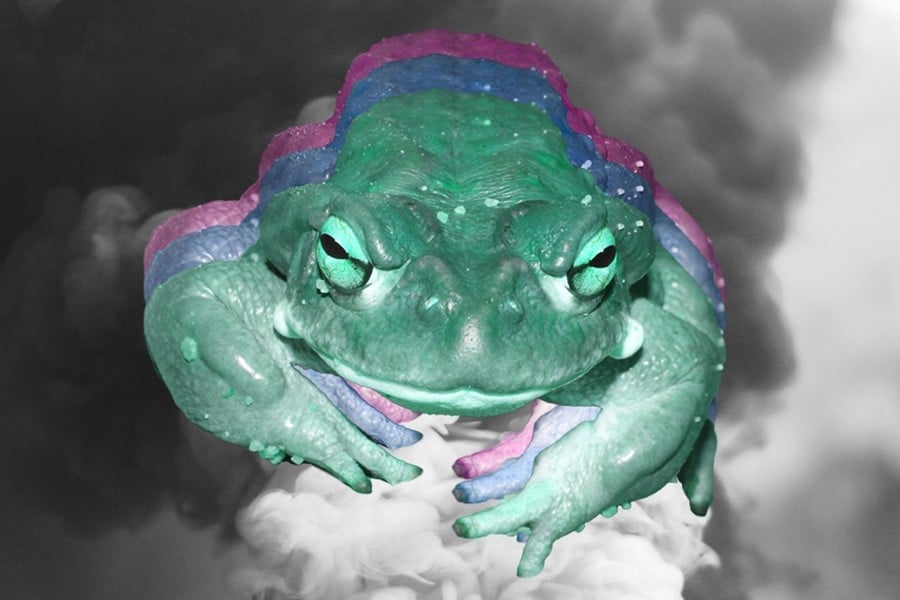This summer, lured by the moist welfare of monsoon rains, thousands of Colorado River toads will emerge from dirt burrows with a singular thought on their tiny amphibian minds: Get laid. At least a few of these toads, however, will almost certainly be kidnapped—temporarily—so that humans can squeeze the glands of these warty little bufonidae and use the resulting goo as medicine.
This milky white venom, which contains a powerful psychedelic compound called 5-MeO-DMT, is rapidly growing in popularity, even if many folks haven’t heard of it yet. It is the focal point of the World Bufo Alvarius Conference, an annual convention hosted in Mexico City; it has become Mike Tyson’s new favorite drug; and Michael Pollan details his experience smoking the “Everest of psychedelics” in his seminal hallucinogenic text How To Change Your Mind. It likely won’t be long before Gwyneth Paltrow hears of it and 5-MeO enters the mainstream pantheon of trippy psychoactive drugs with powerful healing properties.
This curious chemical is found in many plants and at least one species of fungi, but 5-MeO is best known for its presence in the pus-like sacs of Bufo alvarius, sometimes called the Sonoran Desert toad. Its range dots from the southernmost edge of California to southwestern New Mexico and Arizona and down into Mexico, but the toad’s influence is quickly spreading across the globe, as more people get turned onto its strange vibes. (Since 2011, 5-MeO-DMT has been deemed a Schedule 1 substance, making it highly illegal—not that that’s stopping anyone from trying it.)
Even for a psychedelic, the limited research on 5-MeO boasts some nearly miraculous results. Like many psychedelics, research on this substance has filled scientific journals with the promise that it can reverse stubborn addictions, treat depression and PTSD, and improve one’s mood or sense of purpose in life. And all of this with just one puff. A single deep inhalation of vaporized toad will rocket users into a cosmic trip lasting less than half an hour.
As obscure as 5-MeO may be, it is an increasingly controversial drug. Debate rages over which version of the drug is more effective or responsible: synthetic, lab-made 5-MeO or the fresh-squeezed toad variety. Some are concerned with the toad’s well-being, claiming that catch-and-release can add to threats like climate change and habitat destruction that endanger toad populations.
Read: What’s Lost When Psychedelic Mushrooms Become Synthetic Psilocybin
But others prefer nature’s bounty to a lab-made drug. Many swear that the venom itself is a unique blend of medicinal compounds that play off each other like an orchestra. That’s because toad venom contains much more than just 5-MeO-DMT, and these chemicals may work in concert to create an “Entourage Effect,” similar to what’s seen in the multiplicities within cannabis, ayahuasca, and possibly mushrooms. However, some scientists say there isn’t yet enough evidence for this alleged effect in toad venom:
How to Grow Shrooms Bundle
Take Both of Our Courses and Save $90!
In April 2019, Maastricht University PhD candidate and neuropsychologist Malin Uthaug, along with her colleagues, published the first analysis of toad extracts since the ‘60s. Her results contradicted some earlier analysis (more on that later) suggesting there’s a lot more to this story than previously understood.
“[Synthetic 5-MeO-DMT] doesn’t really make a difference for humans experience-wise, but for the toads, the situation is quite different,” Uthaug tells DoubleBlind, attributing any perceived differences for humans to set and setting, or something like a preconceived belief in a toad spirit.
“The milking can introduce bacteria to their ecosystem,” she warns. “It’s also their main defense mechanism for predators, so if you deprive it of that it doesn’t have any way to protect itself.”
There are ways to get around these issues, such as milking infrequently, wearing gloves, and only expressing a few of the toad’s glands. But with the swelling popularity of these amphibian essences, the threats to the animal’s survival are magnifying. It’s worth examining some of the claims of synthetic versus naturally derived.
A Brief History of Smoking Toad Extracts
Despite the fact that 5-MeO-DMT was first synthesized in 1936, and first identified in toads in 1967, there’s still a lot we don’t know about it. While it’s not entirely clear when people started smoking or vaporizing it, for example, most evidence suggests the practice began relatively recently. Ingestion of 5-MeO from other sources dates back centuries, commonly found in indigenous snuff like yopo, which comes from the South American tree Anadenanthera peregrina.
But smoking toad extract specifically is another story. There is some ethnographic evidence of indigenous toad and frog worship, but not enough to say people were smoking Bufo alvarius. As Ali Cotin wrote for Chacruna, “we cannot yet confirm or deny if the substance formed part of [indigenous] traditions.”
Compared to other psychedelics, the physical and mental effects of 5-MeO-DMT are quite unique. Often compared to its cousin DMT (N,N-dimethyltryptamine), both drugs are frequently ranked among the most powerful psychedelics on Earth. However, while DMT is known for its vivid, otherworldly visions and encounters with sentient beings, 5-MeO-DMT often produces little to no visuals at all.
“There were no psychedelic pyrotechnics, I didn’t see crazy colors and geometric patterns pop or anything like that, that you would see with salvia, DMT, LSD or a mushroom trip,” Nick Jikomes, a neuroscientist from Washington, says of his first 5-MeO-DMT experience two years ago. “Just formless blissful white ecstasy…The most ecstatic experience I’ve ever had…The absence of linguistic mental activity, just pure unfiltered undifferentiated consciousness.”
“Just formless blissful white ecstasy…The most ecstatic experience I’ve ever had…The absence of linguistic mental activity, just pure unfiltered undifferentiated consciousness.”
Jikomes, also the director of science and innovation for cannabis encyclopedic website Leafly, says he inhaled 16 to 18 milligrams of synthetic, lab-tested and 98 percent pure 5-MeO, which entered him in a state of “nirvikalpa samadhi,” a level in Buddhist meditation in which the mind completely dissolves, leaving only infinite love and peace.
Jikomes hasn’t personally tried 5-MeO from toad venom, but what more could one ask for than a mindspace of absolute bliss?
“In my experience, the toad venom for people has been more physically medicinal [than synthetic 5-MeO] for those who have had secondary medical issues, like chronic pain, arthritis or gastrointestinal issues,” says Dr. Joseph Barsuglia, a clinical and research psychologist from Calabasas, California, who has administered both synthetic and naturally-occurring toad venom to patients at an addiction treatment center in Mexico.
“The dominant view in the psychedelic community is ‘Leave the toads alone, just use synthetic,’ because it’s an ecological problem,” Barsuglia tells DoubleBlind. “It’s also an economic problem because there are impoverished areas in Mexico where people sell toad venom on Facebook for $300 dollars a gram.”
Prior mystical experiences coupled with therapeutic effects from medical marijuana prompted Barsuglia to look at psychedelics. He was first drawn to the hallucinogenic shrub ibogaine, but soon came across toad venom.
Read: What You Should Know to Have a Safe Kambo Experience
“I was administered 5-MeO-DMT and once I experienced it, I said I’m gonna devote my life to this medicine,” Barsuglia says. “I’ve been on the hunt, as both a spiritual person and a healer, a psychotherapist, and a researcher [to find] what are the medicines that heal people rapidly and connect them spiritually. And I haven’t found more direct medicine than those two.”
Barsuglia later became head of an addiction clinic called Crossroads Treatment Center in Mexico that administered ibogaine and 5-MeO. Alongside other renowned psychedelic researchers, like Alan K. Davis and Roland Griffiths from the Johns Hopkins Center for Psychedelic and Consciousness Research, he’s published numerous papers on 5-MeO-DMT. One such paper compared the “magic” mushroom ingredient psilocybin to 5-MeO-DMT to see which one is more effective for treating mental health. Because 5-MeO doesn’t last as long as psilocybin, it may be advantageous in clinical settings, as it seems to take users to “a non-dual space more reliably than psilocybin,” Barsuglia explains.
“5-MeO may have more medicinal value because it works on sigma receptors, which are associated with the immune function and have anti-inflammatory effects,” he continues. “I feel 5-MeO-DMT is far superior [than psilocybin] in getting out the deeper roots of trauma in the body.”
But because of the quick onset and powerful effects, Barsuglia cautions that 5-MeO is not for people who are inexperienced with other psychedelics. Try mushrooms first, in other words. He compares 5-MeO to an exorcism that “rips your ego off in about five seconds.”
How to Grow Shrooms Bundle
Take Both of Our Courses and Save $90!
He compares 5-MeO to an exorcism that “rips your ego off in about five seconds.”
“Anything that you’re holding in your body, like trauma or depression or anxiety, it’s kind of pulling all that stuff through your body without any ego online to understand what’s happening,” Barsuglia explains. “People are puking and screaming and rolling around. It’s deep somatic release and I don’t think 99 percent of psychiatrists or psychologists would know what to do with that.”
As with most psychedelics, the healing potential of 5-MeO-DMT does not seem confined to a molecule-receptor relationship. That is, the drug alone isn’t doing all the work, but set and setting, as well as who is administering the medicine and how they guide the psychedelic experience, plays an outsized role in how patients respond. That’s why it’s considered best practice to use 5-MeO with a guide who has experience with it.
But if 5-MeO does ever see use in clinical therapy, it likely won’t be sourced from a live amphibian. Like synthetic psilocybin used in clinical trials, if 5-MeO becomes a legally prescribed medication in assisted psychotherapy, it will most likely be lab-made because it’s easier to dose precisely. Still, is anything lost by this difference?
The Entourage Effect
This question isn’t like arguing over the ingredients in a fine wine. The increasing popularity of toad venom is putting it at the center of more negative media attention, such as a recent case of a Spanish porn star charged with manslaughter following the death of a man who smoked toad venom. Toad poaching also seems to be on the rise.
But more importantly, some conservationists have warned that toad populations are increasingly threatened, noting that urban development, pesticide use, and roadkill hazards are among the driving factors. Humans catching toads in the wild doesn’t seem to have quite the same impact as roads, for instance, but with so many different threats, there’s the risk of a cascade effect. Given other examples in nature, it may not take much for a fungal outbreak to completely devastate the toad’s numbers.
Many in the psychedelic space seem to grasp this, but something about that sticky white goo is still too enticing to resist. The venom is also known as a bufotoxin (“bufo” being Latin for toad) and it contains a lot more chemicals than just 5-MeO-DMT. The question is, are these additional compounds psychoactive—that is, do they do anything in the brain?
Read: Redesigning Psychedelic Mushrooms to Never Cause a “Bad Trip”
Some co-occurring drugs like bufotenine, which is also found in red-and-white Amanita muscaria mushrooms and human urine, are certainly psychoactive. This was unknown until 1955, when four prisoners at Ohio State Penitentiary were injected with up to 16mg of bufotenine, but these trips were all extremely uncomfortable. One patient vomited, saying that his “chest feels crushed.” The effects resembled LSD and mescaline, according to the researchers, who wanted to confirm previous anecdotal reports that bufotenine is indeed trippy. (By the way, this experiment design using convicts—and not much informed consent—would probably be considered highly unethical and would not pass an institutional review board, but back then it wasn’t hard to recruit prisoners as subjects, who didn’t exactly understand what they were signing up for.)
That’s not all that’s contained in toad venom. According to Uthaug’s analysis of five dried toad venom samples, there’s also DMT, NMT, DET, N-Methylserotonin, and bufogenin, among others. The issue is, while some of these chemicals would definitely get someone high, the concentrations found so far are so low and vary so much, they probably won’t make much of a noticeable difference.
Last summer at WBAC, the annual toad venom conference, documentary filmmaker and researcher Hamilton Morris puts it this way: “It would be like if you made a sauce that was like a bucket of habanero peppers and then you put one basil leaf in it, and you said, ‘Oh well, the basil really contributes, it plays a big role.’ Maybe. Probably not.”
Morris came out strongly against anyone catching toads outside scientific research. “Analyze the venom, figure out exactly what it contains, figure out how it changes seasonally, and then figure out a sustainable, synthetic way to recreate it,” he suggests. “I feel very strongly that the best conservation tactic would be to use synthetic material,” he adds, presenting a very cheap and very simple synthesis (for organic chemists, at least) to make toad-free 5-MeO-DMT.

Others agree with Morris. Dr. Alex Sherwood, a medicinal chemist at the psychedelic research lab Usona Institute, says there is “likely insignificant” difference between synthetic 5-MeO and toad venom, at least when vaporized. Usona recently manufactured a batch of synthetic 5-MeO-DMT according to GMP, or Good Manufacturing Practice, that’s up to the standards of the U.S. Food and Drug Administration. According to Liz Vanderwerff, a spokesperson with Usona, the nonprofit lab is beginning the next steps to study 5-MeO-DMT in clinical trials. (Beckley Psytech, the startup wing of the psychedelic research non-profit Beckley Foundation, recently secured $3.7 million in Series A funding to also study synthetic 5-MeO-DMT.)
“Though previous published analysis on dried toad venom has demonstrated that it is typically about 30 percent 5-MeO-DMT by mass, the remaining 70 percent is suspected to be comprised of mostly salts, proteins, and other high molecular weight chemicals,” Sherwood says in an email, noting that these other additives would not vaporize readily. According to him, that only leaves two primary volatile components in the venom: 5-MeO-DMT and perhaps bufotenine.
“The more likely explanation for observed differences in effect with the use of synthetic 5-MeO-DMT versus toad venom is the highly variable and unknown doses that are administered with venom,” Sherwood says. “Our lab is performing mass spectrometry analysis to test the hypothesis, and hopefully sharing that data will shed more light on this debate.”
However, Barsuglia isn’t convinced by Morris’s chili metaphor. He says there are numerous compounds found in at least 15 species of toads that are used in traditional medicine, especially Chinese traditional medicine. The evidence is very limited on most of this, but Barsuglia gives two examples: “Bufotenine, there’s not a lot of research on it, but it prolongs the survival rate of mice that have rabies. So it has documented antiviral effects. N-methylserotonin has anti-inflammatory effects and it’s already been patented for reducing menopausal symptoms in women.” In terms of psychoactive experience, there might not be much difference, but the body might feel differently.
Read: The Complete Guide to 4-AcO-DMT: Synthetic Shrooms or in a Class of Its Own?
Barsuglia also doesn’t agree that toads should only be milked for scientific investigation. “There’s been a polarity in the psychedelic community that no one should be using toads ever. Leave the toads alone, don’t touch the toads and I don’t agree with that,” he says. “I think there’s all kinds of indigenous tribes that are starting to use it to heal themselves, it just needs to be done in right relationship and balance…There’s a way to handle the toad where it’s not harmful to them.”
That means not crowding too many toads in containers where they can spread fungal diseases, only milking one gland per toad, wearing gloves, and changing them often. Barsuglia is also making concerted efforts to protect toads and their habitats. In 2017, he joined the toad conservation project Terra Incognita’s board of directors. The program aims to develop sustainable practices and risk reduction techniques for toad gathering by partnering with environmental consultant Kirra Swenerton, and studying the toad’s environment.
But even Barsuglia admits that, with 5-MeO-DMT’s skyrocketing popularity, synthetic versions need to become more widely available. “For mass use, it makes sense to use synthetic,” he says. “It can be produced pretty cheaply and you don’t have to harm any toads, so I think that’s enough reason, if this were to be developed broadly. It’s not sustainable for it to come from toads.”
Jikomes, the cannabis neuroscientist, agrees. “There are powerful entourage effects in nature and there is a lot of importance to the idea of using compounds in combination,” he says. “But we need to be careful to make sure that claims about these effects don’t go beyond what the evidence states.”

DoubleBlind is a trusted resource for news, evidence-based education, and reporting on psychedelics. We work with leading medical professionals, scientific researchers, journalists, mycologists, indigenous stewards, and cultural pioneers. Read about our editorial policy and fact-checking process here.

DoubleBlind Magazine does not encourage or condone any illegal activities, including but not limited to the use of illegal substances. We do not provide mental health, clinical, or medical services. We are not a substitute for medical, psychological, or psychiatric diagnosis, treatment, or advice. If you are in a crisis or if you or any other person may be in danger or experiencing a mental health emergency, immediately call 911 or your local emergency resources. If you are considering suicide, please call 988 to connect with the National Suicide Prevention Lifeline.



